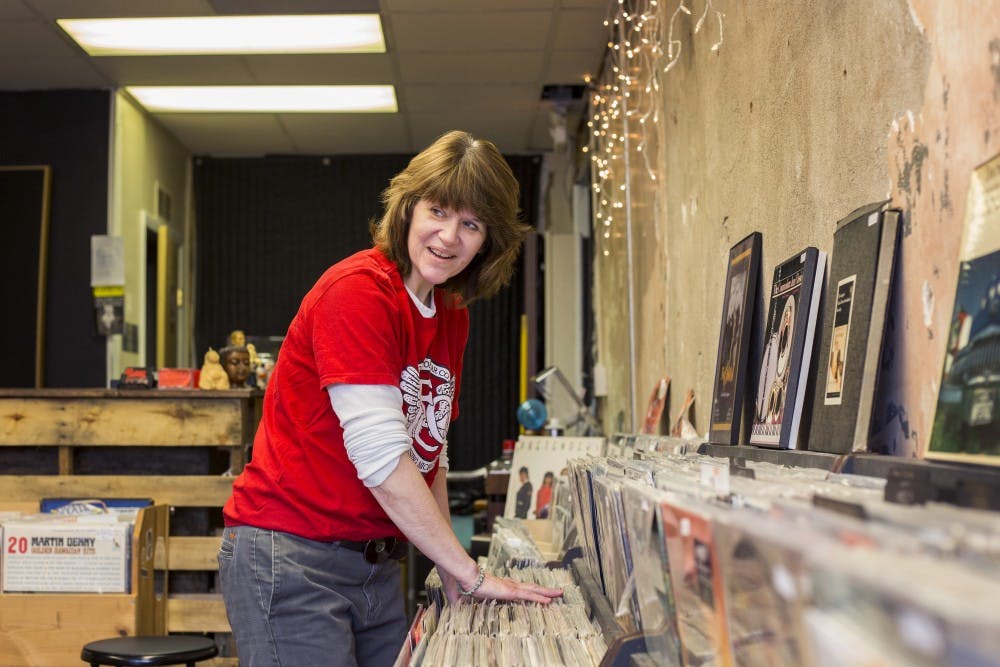2016 was a record year.
From the Olympic Games setting new standards for athletes across the world to the highest recorded temperatures in the past century, 2016 has been a year of surprises.

Owner of the Record Lounge Heather Frarey smiles as a customer walks into the store as she organizes vinyls on April 11, 2017 at the new Record Lounge store at 1132 S Washington Ave in Lansing. "It's like a library, nobody ever puts anything back."
State News File Photo
2016 was a record year.
From the Olympic Games setting new standards for athletes across the world to the highest recorded temperatures in the past century, 2016 has been a year of surprises.
One perhaps lesser-known milestone is that 2016 saw the highest vinyl record sales of the past 25 years.
As streaming services and online music stores have become the new standard for listening to music, some people, old and young, are embracing vinyl records.
“We’ve been pretty amazed that the bubble has not popped, year after year we are saying, ‘Wow, it’s still going,’” Jon Howard, manager of Flat, Black & Circular, said.
Flat, Black & Circular celebrates its 40th anniversary in East Lansing this year.
The 1970s and 80s were the golden age for records. 1978 was the highest-grossing year, with over $2.3 billion in sales.
However, as time went on and new media took over, sales started to drop. Record sales averaged around $20 million per year across the 90s and early 2000s.
A big part of the fall of records was the creation of CDs.
The CD era began in the 90s, growing from $3 billion in sales to $13 billion in just ten years.
The compact size and availability of CD players made music mobile.
During this time, it was also easier to share music and exchange CDs with other music fans.
Sales of CDs started to fall in the early 2000s and have not yet seen a year of higher sales.
Meanwhile, in 2008, record sales started to mount. Finally, in 2016, sales grew to over $400 million.
Howard has lived this history.
“We’ve had to change with the times,” Howard said. “When CDs first came out and then when people started downloading and selling off their CD collection.”
Throughout the ups and down of the music industry, Howard has kept selling vinyl.
“After the initial panic when downloading was kind of the norm, we saw a big uptake in vinyl and then another big uptake.”
Howard believes that in order to understand what draws people to vinyl, one must first be familiar with its history, and its demise.
“The whole cassette thing was both people having cassette players in their cars and that was one format you could record at home,” Howard said.
Support student media! Please consider donating to The State News and help fund the future of journalism.
“People would make mixtapes for their cars or for trading with friends, but I don’t think that was an upgrade in sound at all. It’s just convenience and kind of a cute format.”
Even though cassettes are still being sold, Howard does not expect this pattern to continue. Cassettes were also the first competitors of vinyl, however it was not until CDs were invented that vinyl sales started to drop.
For all the physical styles of music, modern technology and streaming services have made even CDs obsolete.
However, this is the reason that makes the comeback of vinyl so surprising.
“We like it because of sound quality and because it’s kind of almost an art object, something you can hold in your hand and experience,” Howard said. “Rather than just listening to a digital file you can see how the artist is presenting himself or herself or a group. ... We see it as an experience.”
Another reason vinyl is coming back is the social aspect. People like to have a collection and be able to show music rather than just listening to it.
“You see people just buy record collections rather than saying it’s all on the box right here, and I see it a social thing like that,” Howard said.
However, it is not only older music that people are listening to.
New artists are also releasing vinyl copies of their albums.
”We’re seeing a definite mix,” Howard said. “We’re seeing a big comeback to ‘70s rock and the kind of things that were played on the radio. Brand new releases are big also, so we’ve seen a good split.”
Another music enthusiast and record shop owner is Heather Frarey.
Her shop, The Record Lounge, has been in the Lansing area for over nine years.
Frarey said record sales have gone up progressively through the time she’s owned her store, even more so in the last two years.
Like Howard, Frarey agrees that people are drawn to vinyl because of sound quality.
“People say nostalgia, but it does sound a lot better, they’re better made,” Frarey said. “180-gram vinyl gives you a little bit better sound, and everything (the industry is) putting out they are putting out on vinyl.”
A lot of consumers’ relationships with vinyl are personal, Frarey said.
“I think a lot of times they look at their parent maybe their brother or sister who might have been into vinyl back in the day, maybe they would just like a chance to just kind of ‘get in,’ feel what they felt,” Frarey said. “I noticed once they start getting the vinyl, it’s almost like an addiction, they keep going and going with it.”
With vinyl’s comeback, will any other media of music build a similar, long-lived following?
“I don’t think so, for some reason vinyl has just kind of withstood the test of time,” Frarey said.